When it comes to RAM, many people think more is better. While that is true for many reasons, other factors determine the overall performance impact your RAM has on your PC. These include RAM type, speed, size, etc.
In addition, if you ever need to upgrade RAM on your PC and want to add more RAM modules, you must ensure that you get the correct RAM Type since the RAM type is not backward or forward-compatible.
To check RAM Type, you can use built-in services like the Task Manager, Command Prompt, and third-party software like CPU-Z or HWinfo64.
Also Read: How to Check How Much RAM Your Motherboard Can Support?
In this guide, I will thus focus solely on the RAM type and how to check RAM Type in Windows 10 in detail.
However, you can also use the information here to check the RAM type on other operating systems.
Let’s dive right in!
TABLE OF CONTENTS
What are the RAM TYPES Generally Used?
Most modern computers use DDR3, DDR4, or the latest DDR5 RAM. However, there are many other types of RAM, too, archaic as they may be. These include DDR, DDR2, SDRAM, EDO RAM, etc.
Your PC most likely has either DDR3 or DDR4 RAM. You may also have DDR5 if your PC is relatively new. DDR5 is the latest Type of RAM you can find on PCs.
Again, I would like to inform you that RAM Types are NOT backward or forward-compatible. You cannot use a DDR4 stick on a PC designed for DDR5 or vice versa.
Also Read: Will DDR5 RAM Work on DDR4 Motherboard?
How To Check RAM Type in Windows 10
You can check the Type of RAM in your PC in a few ways:
- Window’s built-in Command Prompt
- Task Manager (only for DDR3 and below)
- Third-party tool CPU-Z
- Third-party tool HWInfo64
- You can also physically inspect the RAM sticks to see the Type
Let’s look at how to use each method.
1. Checking RAM Type Using Command Prompt
This is the easiest method to check what RAM Type you have in Windows 10.
However, this method only sometimes works. I will explain it below for you.
- To open the command prompt, open the start menu and type “Command Prompt” in the search bar.
- Right-click the first result that says “Command Prompt” with a black icon.
- Select “Run as Administrator.” Make sure you launch the program as an administrator.
- A black Terminal window will open up. Type in the following command:
Which memory chip gets the device locator, memory type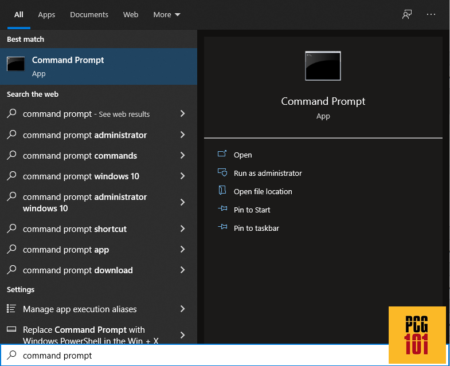
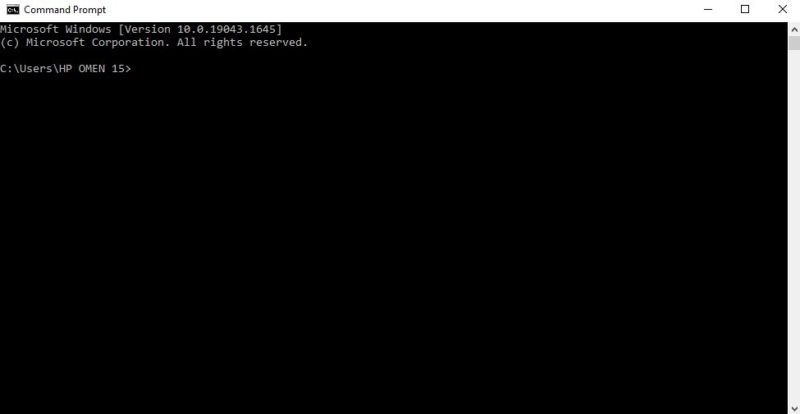
This will display a number under the heading “MemoryType.”
The number you see here is a code specifying your memory type.
Check the number from the list below to check the RAM you use on your PC.
The MemoryType Code I received above was 24, corresponding to DDR3 RAM.
| MemoryType Code | RAM Type |
| 0 | Unknown |
| 1 | Other |
| 2 | DRAM |
| 3 | Synchronous DRAM |
| 4 | Cache DRAM |
| 5 | EDO |
| 6 | EDRAM |
| 7 | VRAM |
| 8 | SRAM |
| 9 | RAM |
| 10 | ROM |
| 11 | FLASH |
| 12 | EEPROM |
| 13 | FEPROM |
| 14 | EPRAM |
| 15 | CDRAM |
| 16 | 3DRAM |
| 17 | SDRAM |
| 18 | SGRAM |
| 19 | RDRAM |
| 20 | DDR |
| 21 | DDR2 |
| 22 | DDR2 FB-DIMM |
| 24 | DDR3 |
| 25 | FBD2 |
| 26 | DDR4 |
As we talked about earlier, this method only sometimes works.
Sometimes the number you get back is ‘0’. Meaning your system was unable to read the MemoryType.
In this case, you won’t be able to use other methods, as highlighted below.
2. Checking RAM Type Using Task Manager (Only for DDR3 and Below)
The second way to check RAM Type in a Windows 10 PC is by using the Task Manager.
This is also a relatively simple method. However, it only works with a DDR3 or older gen RAM.
It does not work for DDR4 or DDR5 RAM modules.
To open the Task Manager, press Control + Alt + Delete and click on Task Manager.
Alternatively, press Control + Shift + Escape to directly open the Task Manager.
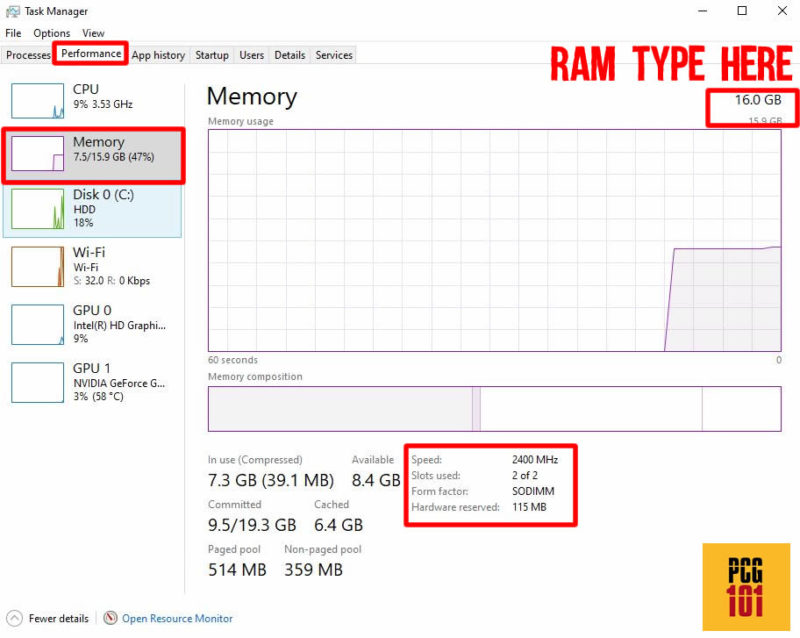
Once the Task Manager window is open, click on the tab named “Performance.” From the column displayed, click on “Memory.”
General details such as RAM size, speed, form factor, etc will appear.
On the top right corner of the window, you can see the Type of RAM you’re using IF YOU HAVE A DDR3 or older RAM module.
I have a DDR4 RAM module, so I cannot see it’s typewritten in the top right corner.
3. Checking RAM Type Through CPU-Z
CPU-Z is a free third-party software you can install to check many hardware information on your PC, including the RAM type.
Click here to download the program. CPU-Z is a very lightweight program that installs quickly.
Once the installation is complete, open up CPU-Z.
Click on the fourth tab labeled “Memory.” The field named Type will list the memory used in your computer.
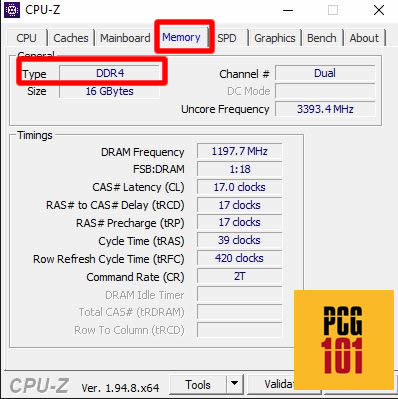
The best part about this method is that you rarely find any issues (as you would with the previous two ways).
Hence, this is the most definitive way to check the RAM Type and is highly recommended.
Also Read: Does My Motherboard Support Quad Channel Memory?
4. Checking RAM Type Through HWiNFO64
HWinfo64 is another program you can install to check the Type of RAM installed on your computer. Click here to download the software.
Once you’ve installed the software, open it up and look for the window named “Motherboard.”
Under that, you’ll see a field labeled as TYPE. This will specify the Type of RAM installed on your PC.
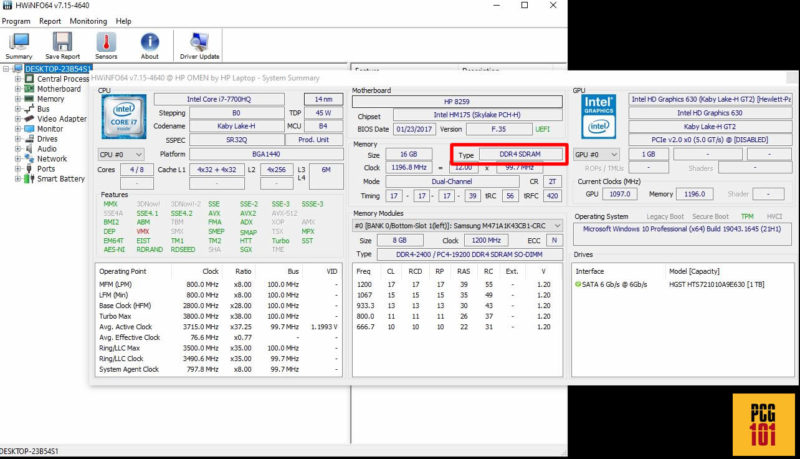
5. Checking RAM Type Through Physical Inspection
Different RAM sticks have notches at different positions and a separate pin count.
This is done so you can only insert the right RAM type in the right slot.
Removing the RAM from your motherboard is a straightforward process. First, look at the tiny clip at the end of the RAM slot on your motherboard.
If your RAM slots are color-coded, the clip should be too. Push the pin downward and outward towards the motherboard to unclip it.
Be very gentle when you do this; it should push the RAM module up while the clip opens up.
The image below shows the notch position on different generations of RAM.
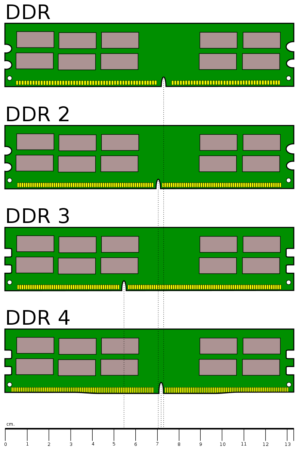
You can also count the number of pins to determine your RAM type.
Desktop-Based (DIMM)
- DDR5 has 288 Pins
- DDR4 has 288 Pins
- DDR 3 has 240 Pins
Laptop-Based (SO-DIMMS)
- DDR4 has 260 pins
- DDR3 has 204 pins
Summing It Up
There are various ways how to check RAM Type in Windows 10. If you don’t want to open up your computer to check the Type of RAM, multiple software helps you do so.
When upgrading your RAM, determining what Type it is is crucial.
So, which Type of RAM are you using in your build? Let me know!
FREQUENTLY ASKED QUESTIONS
1. How can I tell if my Windows 10 computer is running DDR, DDR2, DDR3, DDR4, or DDR5 RAM?
You can check the type of RAM installed on your Windows 10 computer by opening the Task Manager, clicking on the Performance tab, and then selecting the Memory option. The type of RAM will be listed under the “Speed” category.
2. What impact does the type of RAM have on my computer’s performance, and is it worth upgrading to a newer type of RAM?
The type of RAM can have a significant impact on a computer’s performance, as newer types of RAM are generally faster and more efficient. Upgrading to a newer type of RAM can help improve your computer’s speed and performance, but it’s important to make sure that your computer is compatible with the newer type of RAM before making the upgrade.
3. How do I check my computer’s RAM speed, and what effect does it have on performance?
You can check your computer’s RAM speed by opening the Task Manager, clicking on the Performance tab, and then selecting the Memory option.
The RAM speed will be listed under the “Speed” category. RAM speed can impact a computer’s performance by determining how quickly data can be accessed and processed by the computer’s memory.
Higher RAM speeds can result in better overall performance, especially for tasks that require a lot of processing power.
4. What is dual-channel RAM, and how does it differ from single-channel RAM?
Dual-channel RAM refers to a configuration where two identical memory modules are installed in pairs, allowing them to work together to improve memory performance.
This is in contrast to single-channel RAM, which uses only one memory module. Dual-channel RAM can provide better performance for memory-intensive tasks, such as gaming or video editing, but requires that the memory modules be installed in pairs and that the computer’s motherboard support dual-channel memory.
